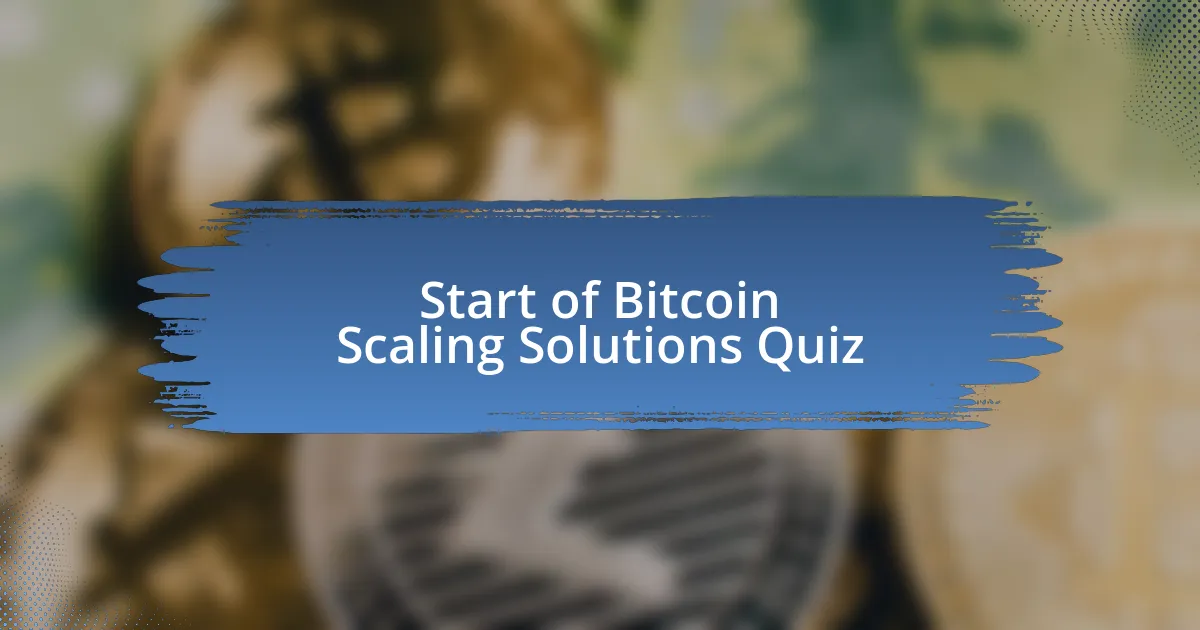
Start of Bitcoin Scaling Solutions Quiz
1. What is the primary method Bitcoin uses to scale without modifying the core protocol?
- By increasing block size.
- By implementing layered solutions.
- By modifying the core protocol.
- By using more miners.
2. What is the name of the layer 2 scaling solution for micropayments and daily transactions on Bitcoin?
- The Lightning Network
- The Flash Network
- The Golden Gateway
- The Quick Transfer System
3. How do payment channels in the Lightning Network operate?
- Payment channels operate only when using traditional banking methods for transfers.
- Payment channels are established without any Bitcoin transactions at any point.
- Payment channels are opened through Bitcoin transactions and can handle many Lightning transactions.
- Payment channels work exclusively with Ethereum transactions for functionality.
4. What is the purpose of Segregated Witness (SegWit)?
- To increase the block size limit and improve mining rewards.
- To enhance the privacy of users by anonymizing transactions.
- To prevent Bitcoin transaction malleability and allow for more transactions to be stored within a block.
- To allow Bitcoin to be used for smart contracts and decentralized applications.
5. What is SegWit2x?
- SegWit2x is a method to decrease transaction fees on Ethereum networks.
- SegWit2x is a marketing campaign to promote Bitcoin Cash over Bitcoin.
- SegWit2x is a proposal that activates Segregated Witness at an 80% threshold of the total bitcoin hash rate and increases the block size limit to 2 MB within six months.
- SegWit2x refers to a central authority controlling Bitcoin`s transaction processing.
6. What is the main difference between SegWit and SegWit2x?
- SegWit optimizes security, while SegWit2x plans to overhaul the user interface.
- SegWit focuses on transaction format changes, while SegWit2x aims to increase the block size limit.
- SegWit changes the Bitcoin mining algorithm, while SegWit2x removes block size limits.
- SegWit is a wallet feature, while SegWit2x is a trading strategy.
7. What is the name of the technology underlying Bitcoin?
- Bitstream
- Datachain
- Blockchain
- CryptoGrid
8. Can Bitcoin be sent to an Ethereum address?
- Only with a special tool.
- Yes, easily.
- Yes, but it`s risky.
- No.
9. What is the purpose of sidechains in Bitcoin?
- To increase the transaction speed on the main chain permanently.
- To create a new cryptocurrency separate from Bitcoin.
- To move BTC from the main chain to independently developed blockchains for transactions and then return it to the main chain.
- To add more mining rewards to Bitcoin miners.
10. What are some prominent sidechain solutions?
- Sidechain`s Ether, Quickchains, and MetaShift.
- BitShares, SmartBlocks, and ChainLink.
- NXT, BlockWaves, and CryptoBridge.
- Blockstream`s Liquid, Stacks, and RootStock.
11. How do Stacks and RootStock differ in their incentive mechanisms?
- RootStock utilizes a direct sale of tokens to fund its development and operations.
- RootStock offers rewards through centralized token distribution to prevent miner collusion.
- Stacks provides incentives by issuing a fixed supply of tokens to all users monthly.
- Stacks` native token, STX, can be staked to earn transaction fees paid in BTC.
12. What is the Taproot Protocol?
- A new mining algorithm for Bitcoin mining.
- A method for converting Bitcoin to cash instantly.
- A scaling solution that enhances the functionality of Bitcoin by allowing more complex smart contracts and improving privacy.
- A type of wallet that stores Bitcoin securely.
13. What is the purpose of mainnet upgrades in Bitcoin scaling?
- To decrease the number of transaction confirmations needed for blocks.
- To eliminate the use of miners in the Bitcoin network entirely.
- To create a completely new cryptocurrency based on Bitcoin`s technology.
- To improve the performance and functionality of the Bitcoin network by updating its core protocol.
14. What is one-way transfer in Bitcoin scaling?
- A system where transactions can repeatedly move between chains regardless of direction.
- A way to split transactions into smaller batches for increased speed.
- A method where transactions are sent to a sidechain and then cannot be returned to the main chain.
- A technique that allows unlimited transactions to be processed simultaneously.
15. What is the name of the off-chain scaling solution that is being developed to mitigate Bitcoin`s fees and long transaction times?
- The SegWit Network
- The Lightning Network
- The RootStock Network
- The Blockstream Network
16. How does the Lightning Network reduce transaction costs?
- By using smart contracts and payment channels, allowing for near-zero cost transactions.
- By increasing block size limits during peak hours.
- By converting transactions into tokens on another blockchain.
- By eliminating the need for miners entirely in transactions.
17. What is the relationship between Bitcoin and its layers?
- Bitcoin layers increase the block size limit, allowing for more immediate transactions on the main chain.
- Bitcoin layers separate transaction types to prevent network congestion during peak hours.
- Bitcoin layers enable miners to receive higher rewards per block by diversifying transaction methods.
- Bitcoin layers allow transactions to be transferred without directly using the blockchain, enhancing performance and functionality.
18. How often can we expect a new block to be found by miners?
- Every 15 minutes.
- Every 10 minutes.
- Every 5 minutes.
- Every hour.
19. What is Bitcoin Pizza Day?
- The day when a computer programmer paid 10,000 bitcoins for two pizzas in 2010.
- A celebration of Bitcoin`s first birthday in 2011.
- An event marking Bitcoin`s first price increase in 2013.
- The day Bitcoin was created by Satoshi Nakamoto.
20. What is SHA-256?
- A digital wallet for storing cryptocurrency.
- A consensus mechanism for blockchain validation.
- A secure hashing algorithm used by Bitcoin, originally designed by the NSA.
- A programming language for Bitcoin transactions.
21. What is a nonce in Bitcoin?
- An empty value in each block that is filled by the miner of that block.
- A special code that represents a user`s Bitcoin balance.
- A fixed value used to identify transactions in a block.
- A predefined block size limit set by Bitcoin miners.
22. What is difficulty in relation to Bitcoin?
- A system that verifies the legitimacy of Bitcoin wallets.
- A measure of how difficult it is to find a hash below the target.
- An indicator of the total number of transactions in the network.
- A method for converting Bitcoin into fiat currency.
23. What is multi-sig verification?
- A method of verifying transactions using multiple signatures.
- A technique for reducing transaction speeds by utilizing fewer confirmations.
- A system that relies on user passwords for authentication.
- A style of transaction that requires only one signature to proceed.
24. What is the primary advantage of sidechains in Bitcoin?
- They enhance mining rewards by splitting fees between chains.
- They allow for off-chain transactions, reducing congestion on the main chain.
- They provide an immutable record for every transaction made.
- They increase the block size limit for faster transactions.
25. What are some common criticisms of sidechains?
- They can introduce complexity and require additional infrastructure.
- They can only be used for a single transaction.
- They eliminate the need for security entirely.
- They are always slower than the main chain.
26. How do mainnet upgrades improve Bitcoin`s scalability?
- By cutting the transaction time for each block to less than five minutes.
- By reducing the transaction fee for all operations on the main chain.
- By adding more miners to the network and increasing rewards.
- By increasing block size limits or implementing new consensus mechanisms.
27. What is the purpose of Taproot Protocol in Bitcoin?
- To eliminate mining fees entirely.
- To limit the block size for quicker transactions.
- To enhance the functionality of Bitcoin by allowing more complex smart contracts and improving privacy.
- To reduce the number of Bitcoin transactions.
28. What is one-way transfer in Bitcoin?
- A process that allows Bitcoin to be exchanged for other cryptocurrencies freely.
- A system that enables peer-to-peer transactions without intermediaries.
- A method where transactions are sent to a sidechain and then cannot be returned to the main chain.
- A technique where transactions can be reversed for a limited time.
29. What is the purpose of Segregated Witness (SegWit) in Bitcoin`s scaling solutions?
- To limit the number of transactions that can be made in a day.
- To prevent transaction malleability and allow more transactions in a block.
- To introduce a new currency for transactions at lower fees.
- To eliminate all fees associated with Bitcoin transactions.
30. Which Bitcoin scaling solution is known for enabling fast micropayments and reducing fees significantly?
- The SegWit Protocol
- The Lightning Network
- The Blockstream Layer
- The Bitcoin Cash Fork

Congratulations on Completing the Quiz!
You’ve successfully finished the quiz on Bitcoin Scaling Solutions. This journey has offered insights into various methods designed to increase Bitcoin’s transaction capabilities. You may have explored concepts like SegWit, the Lightning Network, and other innovative approaches. Each topic reveals how the Bitcoin community addresses scalability challenges.
Through this quiz, you likely gained a deeper understanding of how these solutions work and their implications for Bitcoin’s future. You might have learned about the balance between security, decentralization, and throughput. This knowledge is vital as Bitcoin continues to evolve in a rapidly changing financial landscape.
To further enhance your understanding, we invite you to explore the next section on this page about Bitcoin Scaling Solutions. There, you’ll find more detailed information and resources that can deepen your knowledge. Dive in to discover more about how these solutions can shape the future of Bitcoin!

Bitcoin Scaling Solutions
Overview of Bitcoin Scaling Solutions
Bitcoin scaling solutions are methods and technologies designed to enhance the capacity of the Bitcoin network to handle more transactions per second. These solutions arise from concerns about network congestion and high transaction fees during peak usage. Key strategies involve increasing block size or optimizing how transactions are processed. The escalating popularity of Bitcoin has led to frequent discussions about efficient mechanisms to improve its transaction throughput, ensuring it remains viable as a global payment system.
Layer 1 Solutions for Bitcoin Scaling
Layer 1 solutions focus on making changes to the Bitcoin protocol itself. The most common method involves increasing the block size limit, allowing more transactions to be included in each block. Another approach is reducing block time, which can lead to faster transaction validation. These solutions aim to directly enhance Bitcoin’s base layer, improving its scalability while maintaining its decentralized characteristics. Examples include the Bitcoin Improvement Proposals (BIPs) that advocate for these changes.
Layer 2 Solutions in Bitcoin Scaling
Layer 2 solutions work on top of the Bitcoin blockchain to enhance transaction capacity without altering the core protocol. The Lightning Network is the most notable example. It creates off-chain channels for fast, low-cost transactions, effectively alleviating network congestion. Transactions in these channels are settled later on the main blockchain, reducing the load. This method maintains security while enabling scalability, catering to everyday micropayments and rapid transactions.
Segregated Witness (SegWit) and Its Impact
Segregated Witness, or SegWit, is a significant Bitcoin upgrade introduced in 2017. It separates transaction signatures from transaction data, effectively increasing the block size limit without modifying existing rules drastically. This change allows more transactions to fit in each block, enhancing scalability. SegWit also addresses transaction malleability, improving the effectiveness of Layer 2 solutions like the Lightning Network. Its implementation has led to wider adoption and reduces fees on the network.
Challenges and Trade-offs of Bitcoin Scaling Solutions
Scaling Bitcoin presents both challenges and trade-offs. Larger block sizes can lead to centralization if fewer nodes can support the increased resource demands. Conversely, Layer 2 solutions may introduce complexities in usability and require trust in intermediaries. Ensuring security while scaling is a primary concern, as any vulnerabilities could lead to exploitation. Balancing scalability, decentralization, and security remains crucial in the ongoing development of Bitcoin scaling solutions.
What are Bitcoin scaling solutions?
Bitcoin scaling solutions refer to techniques and innovations designed to increase the transaction throughput of the Bitcoin network. These solutions aim to address the limitations of Bitcoin’s block size and transaction speed. Examples include the Lightning Network, which allows off-chain transactions, and Segregated Witness (SegWit), which optimizes block space by separating transaction signatures. According to recent assessments, the Lightning Network can handle millions of transactions per second, significantly enhancing Bitcoin’s scalability.
How do Bitcoin scaling solutions work?
Bitcoin scaling solutions work by either increasing the capacity of the blockchain directly or enabling transactions to occur off-chain. For instance, SegWit modifies how data is stored, allowing more transactions per block without altering the block size limit. The Lightning Network, on the other hand, creates payment channels between users, facilitating rapid transactions without recording every interaction on the blockchain. This two-tiered approach helps manage higher volumes of transactions efficiently.
Where are Bitcoin scaling solutions implemented?
Bitcoin scaling solutions are implemented within the Bitcoin network and in various wallets and applications that support them. The Lightning Network operates on top of the Bitcoin blockchain, allowing users to interact via compatible wallets. SegWit has been adopted by many exchanges and wallets to optimize transaction processing. As of 2023, over 75% of Bitcoin transactions are processed using SegWit, showcasing widespread implementation.
When were Bitcoin scaling solutions developed?
Bitcoin scaling solutions began development shortly after Bitcoin’s launch in 2009, as early scalability concerns arose. SegWit was proposed in 2015 and activated in 2017, marking a significant milestone. The Lightning Network project started in 2015 as well, with its first beta implementations appearing in 2018. Ongoing improvements and proposals for additional scaling solutions continue as the network evolves.
Who benefits from Bitcoin scaling solutions?
Cryptocurrency users, businesses, and developers benefit from Bitcoin scaling solutions. Users experience faster transaction times and lower fees. Businesses can process larger volumes of transactions without delays, making them more competitive. Developers gain from enhanced capabilities for building applications on the Bitcoin network. The scalability of Bitcoin directly impacts market adoption and usability for all stakeholders involved.


